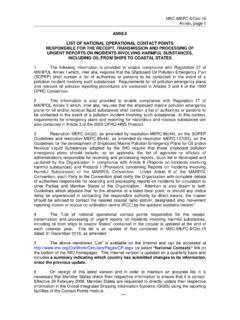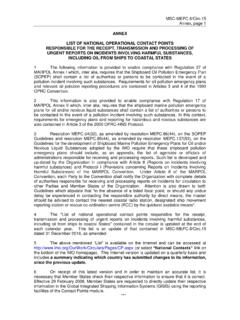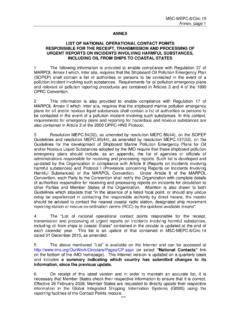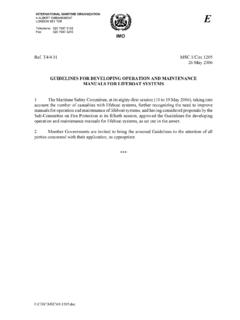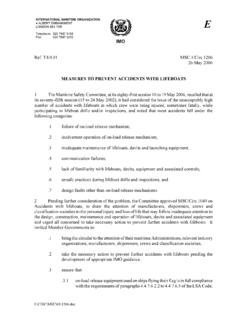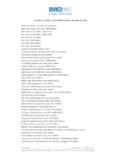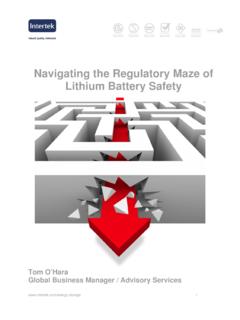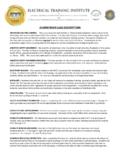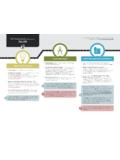Transcription of 4 ALBERT EMBANKMENT LONDON SE1 7SR - IMO
1 I:\CIRC\MSC\01\ E 4 albert embankment london se1 7sr Telephone: +44 (0)20 7735 7611 Fax: +44 (0)20 7587 3210 16 June 2017 ECDIS GUIDANCE FOR GOOD PRACTICE 1 The Maritime safety Committee, at its ninety-fifth session (3 to 12 June 2015), approved the ECDIS Guidance for Good Practice, drawing together relevant guidance from seven previous ECDIS circulars into a single, consolidated document. 2 The undeniable safety benefits of navigating with Electronic Chart Display and Information Systems (ECDIS) were recognized through Formal safety Assessments submitted to the Organization and experience gained by the voluntary use of ECDIS for many years. ECDIS was mandated for carriage by High-Speed Craft (HSC) as early as 1 July 2008.
2 Subsequently, the mandatory carriage of ECDIS for ships other than HSC (depending on the ship type, size and construction date, as required by SOLAS regulation ) commenced in a phased manner from 1 July 2012 onwards. 3 ECDIS is a complex, safety -relevant, software-based system with multiple options for display and integration. The ongoing safe and effective use of ECDIS involves many stakeholders including seafarers, equipment manufacturers, chart producers, hardware and software maintenance providers, shipowners and operators, and training providers. It is important that all these stakeholders have a clear and common understanding of their roles and responsibilities in relation to ECDIS. 4 ECDIS was accepted as meeting the chart carriage requirements of SOLAS regulation V/19 in 2002.
3 Over the years, IMO Member States, hydrographic offices, equipment manufacturers and other organizations have contributed to the development of guidance on a variety of ECDIS-related matters. Over the years, IMO has issued a series of complementary circulars on ECDIS. 5 While most useful IMO guidance on ECDIS was developed in this incremental manner, the information needed to be consolidated, where possible, to have ECDIS-related guidance within a single circular, which could be easily kept up to date without duplication or need for continual cross-referencing. Such consolidation of information offers clear and unambiguous understanding of the carriage requirements and use of ECDIS. 6 The consolidated guidance termed "ECDIS Guidance for Good Practice" is set out in the annex to this circular (referred to as "Guidance" hereafter).
4 Ship operators, masters and deck officers on ECDIS-fitted ships are encouraged to use this guidance to improve their understanding and facilitate safe and effective use of ECDIS. Page 2 I:\CIRC\MSC\01\ 7 The Maritime safety Committee, at its ninety-eighth session (7 to 16 June 2017), based on a recommendation from the fourth session of the Sub-Committee on Human Element, Training and Watchkeeping (30 January to 3 February 2017), and noting the need to clarify the requirement of ECDIS familiarization as specified in the STCW Convention, 1978, as amended, and the ISM Code, approved the revision of the ECDIS Guidance for Good Practice, as set out in the annex. 8 Members of the Organization and all Contracting Governments to the SOLAS Convention are invited to bring this circular to the attention of all entities concerned.
5 In particular, port States are invited to make the guidance available to their port State control inspectors, and flag States to shipowners, masters, recognized organizations, flag State control inspectors and surveyors. An electronic copy of this circular can be downloaded from the Organization's website at: ( ). 9 This circular revokes , and Corrigenda 1, , , , , and ** Annex, page 1 I:\CIRC\MSC\01\ ANNEX ECDIS GUIDANCE FOR GOOD PRACTICE TABLE OF CONTENTS INTRODUCTION ..2 A CHART CARRIAGE REQUIREMENT OF SOLAS .. 2 B MAINTENANCE OF ECDIS SOFTWARE .. 3 C OPERATING ANOMALIES IDENTIFIED WITHIN ECDIS .. 4 D DIFFERENCES BETWEEN RASTER CHART DISPLAY SYSTEM (RCDS) AND ECDIS .. 5 E ECDIS TRAINING .. 6 F TRANSITIONING FROM PAPER CHART TO ECDIS NAVIGATION.
6 7 G GUIDANCE ON TRAINING AND ASSESSMENT IN THE OPERATIONAL USE OF ECDIS SIMULATORS .. 8 APPENDIX 1 LIST OF ECDIS APPARENT OPERATING AND DISPLAY ANOMALIES APPENDIX 2 DIFFERENCES BETWEEN RASTER CHART DISPLAY SYSTEM RCDS) AND ECDIS APPENDIX 3 GUIDANCE ON TRAINING AND ASSESSMENT IN THE OPERATIONAL USE OF ECDIS SIMULATORS REFERENCES Annex, page 2 I:\CIRC\MSC\01\ INTRODUCTION 1 The undeniable safety benefits of navigating with Electronic Chart Display and Information Systems (ECDIS) were recognized through Formal safety Assessments submitted to the Organization and experience gained by the voluntary use of ECDIS for many years. ECDIS was mandated for carriage by High-Speed Craft (HSC) as early as 1 July 2008. Subsequently, the mandatory carriage of ECDIS for ships other than HSC (depending on the ship type, size and construction date, as required by SOLAS regulation ) commenced in a phased manner from 1 July 2012 onwards.
7 2 ECDIS is a complex, safety -relevant, software-based system with multiple options for display and integration. The ongoing safe and effective use of ECDIS involves many stakeholders including seafarers, equipment manufacturers, chart producers, hardware and software maintenance providers, shipowners and operators, and training providers. It is important that all these stakeholders have a clear and common understanding of their roles and responsibilities in relation to ECDIS. 3 This ECDIS Guidance for Good Practice, referred to as "Guidance" hereafter, draws together relevant guidance from seven previous ECDIS circulars into a single, consolidated document. The guidance is laid out in seven sections, namely: A. Chart carriage requirement of SOLAS B.
8 Maintenance of ECDIS software C. Operating anomalies identified within ECDIS D. Differences between raster chart display system (RCDS) and ECDIS E. ECDIS training F. Transitioning from paper chart to ECDIS navigation G. Guidance on training and assessment in the operational use of ECDIS simulators 4 This guidance is intended to assist smooth implementation of ECDIS and its ongoing safe and effective use on board ships. Ship operators, masters and deck officers on ECDIS-fitted ships are encouraged to use this guidance to improve their understanding and facilitate safe and effective use of ECDIS. 5 Although this guidance replaces seven IMO ECDIS-related circulars, there remain several other IMO circulars that also address ECDIS matters to varying degree and reference should also be made to these circulars where necessary.
9 A list containing the IMO ECDIS performance standards and the other IMO circulars that relate to ECDIS is provided in the reference section. A CHART CARRIAGE REQUIREMENT OF SOLAS 6 The mandatory carriage of ECDIS, as required by SOLAS regulation , is subject to a staged entry into force between 1 July 2012 and 1 July 2018. As per SOLAS regulations V/18 and V/19, for a ship to use ECDIS to meet the chart carriage requirements of SOLAS, the ECDIS equipment must conform to the relevant IMO performance standards. ECDIS units on board are required to comply with one of two performance standards (either IMO resolution (19), as amended or resolution (82)), depending on the date of Annex, page 3 I:\CIRC\MSC\01\ their installation. Essentially, where an ECDIS is being used to meet the chart carriage requirements of SOLAS, it must.
10 1 be type-approved; .2 use up-to-date electronic nautical charts (ENC); .3 be maintained so as to be compatible with the latest applicable International Hydrographic Organization (IHO) standards; and .4 have adequate, independent back-up arrangements in place. 7 According to SOLAS regulation V/18, ECDIS units on board ships must be type-approved. Type approval is the certification process that ECDIS equipment must undergo before it can be considered as complying with IMO performance standards. The process is carried out by flag Administration-accredited type-approval organizations or marine classification societies in accordance with the relevant test standards developed by, inter alia, the International Electrotechnical Commission (IEC) ( IEC 61174). 8 In accordance with SOLAS regulation , ships must carry all nautical charts necessary for the intended voyage.
